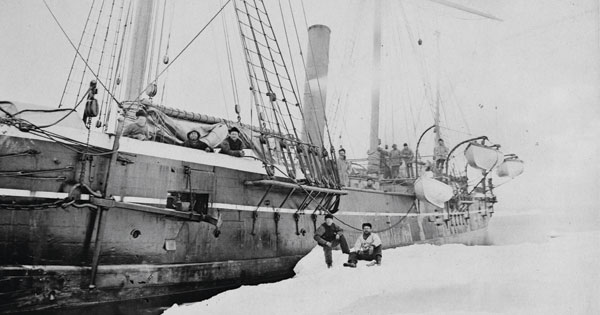
In the Kingdom of Ice: The Grand and Terrible Polar Voyage of the USS Jeannette, by Hampton Sides, Doubleday, 480 pp., $28.95
There was a time, before aircraft and icebreakers, before it began to melt, when the Arctic combined the elusive charisma of the moon with the mortality rate of Everest. For centuries, the North Pole represented a kind of secular grail, the object of a chivalric quest the success of which was sure to bring honor to man and nation alike. So remote and poorly understood were the polar regions that it seems anyone with a convincing pedigree and a salesman’s persistence could sell a theory about what lay beyond the icy barricades of Latitude 70.
In the mid-19th century, the theory of an open polar sea held that the impenetrable ice encountered by explorers and whalers in the Far North was merely a ring and that beyond it, warmed (somehow) by southerly currents, lay open water and a clear route to the pole. Drift and bust your way through this “girdle” of ice, asserted the eminent German geographer and armchair explorer August Petermann, and you were home free. If this sounds like wishful thinking, it was, but many Arctic veterans—from cartographers to whaling captains—considered the theory plausible. For the crew members of the U.S. Arctic Expedition of 1879, the most sophisticated and well-financed effort of its kind ever launched, the absence of an open polar sea would be the least of their problems.
Hampton Sides has a gift for breathing new life into history we thought we knew. In his stately, propulsive prose, he gives us a personal stake in the expedition: if successful, the United States, still a young aspirant to the world stage, will put the pole and itself on the map. It will also give James Gordon Bennett Jr., the owner of The New York Herald and the mission’s principal backer, a worthy follow-up to his paper’s last blockbuster, Stanley’s search for Dr. Livingstone.
Sides’s masterly account of the USS Jeannette and her 33-man crew’s odyssean journey in search of the North Pole builds slowly. The first third of the book lays the practical and theoretical groundwork for the expedition, the times, the state of science and, most important, the Jeannette’s personnel. They are led by Lieutenant Commander George Washington De Long, an ambitious and romantic career Navy man with a gift for understatement. Finding his vessel trapped indefinitely in pack ice, he allows that the Arctic is “a glorious country to learn patience in.” Many members of the crew are equally impressive, and we get to know them, not only by their names and ranks, but also by their characters and motives, and by the hidden wounds they bear. Then there is the Arctic itself, “this desert of ice, piled upon hummocks and forced into mountainous ridges by a force that the mind cannot comprehend,” as a Herald reporter described it.
De Long’s leadership comes to the fore after the Jeannette is caught in the shifting ice of the Arctic Ocean. Sides’s account of what follows—on par with Alfred Lansing’s Endurance and Piers Paul Read’s Alive—documents a series of random catastrophes and staggering heroics that took nearly three years to play out. Polar ice, like the mills of God, grinds exceedingly slow and fine, and Sides, aided by sailors’ logs and journals and the heartbreaking letters of loved ones left behind, plunges us into the mix at a granular level. I was hunched forward in my chair, groaning aloud with every setback and obstacle encountered by these extraordinary men whose equal is, frankly, hard to imagine today.
 Even after nearly two years of relentless compression in the ice pack, when the Jeannette finally succumbs and the captain issues the order to abandon ship, the crew is still intact. De Long’s strategies for keeping his men not just alive but united on the heaped and jumbled ice, in unimaginable cold, a thousand miles from land, are worth the close attention of any modern leader. However, De Long is so temperate, stalwart, and relentlessly optimistic that I couldn’t help wondering what Sides might have left out. Naval discipline was a brutal business in the 19th century, and this commander kept dissent to a minimum. Despite years of darkness, monotony, privation, and chronic terror—certainly fertile ground for mutiny and despair—De Long maintained control and momentum, apparently hands-free. Although there is ample evidence to suggest that he was a genius at choosing and managing men, he also seems too good be true.
Even after nearly two years of relentless compression in the ice pack, when the Jeannette finally succumbs and the captain issues the order to abandon ship, the crew is still intact. De Long’s strategies for keeping his men not just alive but united on the heaped and jumbled ice, in unimaginable cold, a thousand miles from land, are worth the close attention of any modern leader. However, De Long is so temperate, stalwart, and relentlessly optimistic that I couldn’t help wondering what Sides might have left out. Naval discipline was a brutal business in the 19th century, and this commander kept dissent to a minimum. Despite years of darkness, monotony, privation, and chronic terror—certainly fertile ground for mutiny and despair—De Long maintained control and momentum, apparently hands-free. Although there is ample evidence to suggest that he was a genius at choosing and managing men, he also seems too good be true.
Far more pressing, though, is this question: Did the crew of the Jeannette survive? Ebenezer Nye, a seasoned whaler all too familiar with the ferocious whims of Arctic ice, puts it to us this way: “You may get through. Or you may go to the devil—and the chances are about equal.”
The astonishing answer is more than worth the journey.

